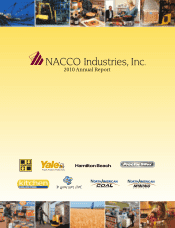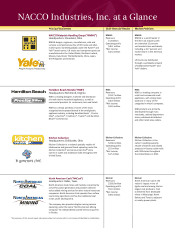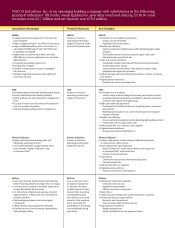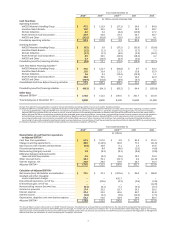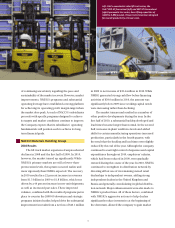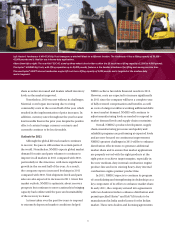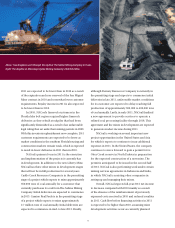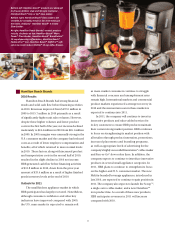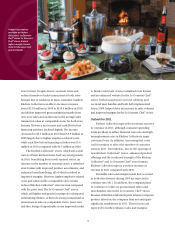Hamilton Beach 2010 Annual Report Download - page 6
Download and view the complete annual report
Please find page 6 of the 2010 Hamilton Beach annual report below. You can navigate through the pages in the report by either clicking on the pages listed below, or by using the keyword search tool below to find specific information within the annual report.
c c c 3c c c
Introduction
In 2010, as global markets and consumer
confidence improved, NACCO Industries, Inc. and its
subsidiaries realized the benefits of its existing long-
term programs and the aggressive cost containment
actions put in place to combat the global recession
of 2008-09. These programs and actions–along with
improvements in volumes at the materials handling
and housewares subsidiaries resulting from the
improved markets, and
increased deliveries at
the Company’s mining
operations–led to 2010
financial results which
were significantly better
than in 2009.
Markets improved at
all of our subsidiaries. At
the end of 2009, NACCO
Materials Handling Group
(“NMHG”) was concerned
that lift truck markets
served by NMHG would
recover only gradually from
the recession. In fact, beginning early in the second
quarter of 2010, those markets improved more rapidly.
Consumer markets, which showed improvement at
the end of 2009, continued to improve during 2010.
However, the recovery in the mass consumer market,
where Hamilton Beach Brands (“HBB”) and Kitchen
Collection are primarily focused, was not as strong
as in the high-end consumer market. Mass-market
consumers continued to struggle with high unemploy-
ment rates and financial concerns. Demand for lignite
from customers served by The North American Coal
Corporation (“NACoal”) remained steady, and the
limerock mining market in southern Florida improved
as mining permits, which had been suspended during
2009, were reinstated in early 2010, resulting in a
significant improvement in limerock yards delivered.
However, during the year, particularly the second half
of 2010, market improvements in all of NACCO’s busi-
nesses were accompanied by increasing commodity
costs and, for NMHG and HBB, adverse changes in
foreign currency exchange rates.
Overall, in the context of these general economic
conditions, NACCO’s subsidiaries returned to more
normal operating levels in 2010 after the deep market
declines of 2008 and 2009. Given 2010 market levels,
strong results were achieved at NMHG, HBB and
NACoal in 2010 and significant strides were made
at Kitchen Collection, where improvement is still
necessary at the Le Gourmet Chef®store format.
Consolidated revenues for NACCO increased to
$2.7 billion in 2010 from $2.3 billion in 2009, with the
increase primarily driven by volume improvements
at NMHG. Net income(1) increased substantially to
$79.5 million, or $9.53 per diluted share, compared
with net income of $31.1 million, or $3.75 per diluted
share, in 2009, which included income from discon-
tinued operations of $22.6 million from the sale of
NACoal’s Red River Mining Company. Income from
continuing operations(1) was $8.5 million, or $1.03
per diluted share, in 2009.
Offsetting these favorable subsidiary results in
2010 were costs of $18.8 million ($12.2 million after
tax of $6.6 million) at NACCO for litigation initiated
in 2006 against Applica Incorporated (“Applica”) and
individuals and entities affiliated with Applica’s share-
holder, Harbinger Capital Partners Master Fund I Ltd.,
related to NACCO’s failed transaction with Applica in
2006. On February 14, 2011, the parties to the Applica
litigation entered into a settlement agreement. The
settlement agreement provides for, among other
things, the payment of $60 million ($39.0 million after
taxes of $21.0 million) to NACCO and dismissal of
the lawsuit with prejudice. NACCO expects to incur
additional litigation costs for the first two months of
To Our Stockholders
Subsidiary Financial Objectives:
• NMHG: Achieve an operating profit
margin of 9 percent at the peak of
the market cycle.
• HBB: Achieve a minimum operating
profit margin of 10 percent.
• Kitchen Collection: Achieve a
minimum operating profit margin
of 5 percent.
• NACoal: Earn a minimum return
on capital employed of 13 percent
and attain positive Economic
Value Income from all existing
consolidated mining operations and
any new projects while maintaining
or increasing the profitability of all
existing unconsolidated mining
operations
• All subsidiaries: Generate substantial
cash flow before financing activities.
(1) For purposes of this annual report, discussions about income/loss from continuing operations and net income/loss refer to income/loss from continuing
operations attributable to stockholders and net income/loss attributable to stockholders.

